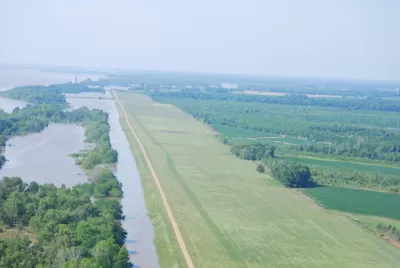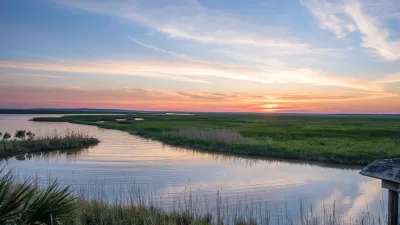A $50 billion plan to replenish lost coastal land could have significant impacts on local marine life and fishing industries.

The U.S. Army Corps of Engineers has released the environmental impact statement that allows a key component of a massive coastal restoration project planned for the Louisiana coast to move forward. Writing in the New York Times, John Schwartz reports that the Corps called the proposed project largely beneficial but expressed concern for the effects it could have on marine life.
The Mid-Barataria Sediment Diversion project is designed to replenish the sediment that has eroded away from Louisiana's coast, sediment that was naturally replenished before man-made levees contained the flow of the river. "If the corps issues final permits, which could happen as early as next year, a $1.4 billion structure will be dug into the western bank of the river below New Orleans. It will include gates that allow operators to control the flow of water and sediment from the mighty river into Barataria Bay, nearly an Olympic swimming pool’s worth of water every second."
To counter negative impacts, the project sets aside "millions of dollars to monitor dolphin populations and protect them, as well as helping to pay to relocate oyster beds to areas that will have the right level of salinity" and fund boat upgrades to help fishermen reach waters farther ashore. Acknowledging the dangers as well as the necessity of the project, Richie Blink, a council member of the Plaquemines Parish government, emphasized the importance of a safety net for "the people who are impacted most by the structure and the project." Opponents argue there are less destructive ways to stave off the effects of erosion, but those methods are more expensive and require more maintenance. Without the project, said Bren Haase, executive director of the state coastal authority, "the alternative is unthinkable. It’s a coastal Louisiana that doesn’t exist."
FULL STORY: Big Step Forward for $50 Billion Plan to Save Louisiana Coast

Americans May Be Stuck — But Why?
Americans are moving a lot less than they once did, and that is a problem. While Yoni Applebaum, in his highly-publicized article Stuck, gets the reasons badly wrong, it's still important to ask: why are we moving so much less than before?

Using Old Oil and Gas Wells for Green Energy Storage
Penn State researchers have found that repurposing abandoned oil and gas wells for geothermal-assisted compressed-air energy storage can boost efficiency, reduce environmental risks, and support clean energy and job transitions.

Placekeeping: Setting a New Precedent for City Planners
How a preservation-based approach to redevelopment and urban design can prevent displacement and honor legacy communities.

San Francisco’s Muni Ridership Grew in 2024
The system saw its highest ridership since before the Covid-19 pandemic, but faces a severe budget shortage in the coming year.

Colorado Lawmakers Move to Protect BRT Funding
In the face of potential federal funding cuts, CDOT leaders reasserted their commitment to planned bus rapid transit projects.

Safe Streets Funding in Jeopardy
The Trump administration is specifically targeting bike infrastructure and other road safety projects in its funding cuts.
Urban Design for Planners 1: Software Tools
This six-course series explores essential urban design concepts using open source software and equips planners with the tools they need to participate fully in the urban design process.
Planning for Universal Design
Learn the tools for implementing Universal Design in planning regulations.
Heyer Gruel & Associates PA
City of Moreno Valley
Institute for Housing and Urban Development Studies (IHS)
City of Grandview
Harvard GSD Executive Education
Salt Lake City
NYU Wagner Graduate School of Public Service
City of Cambridge, Maryland



























